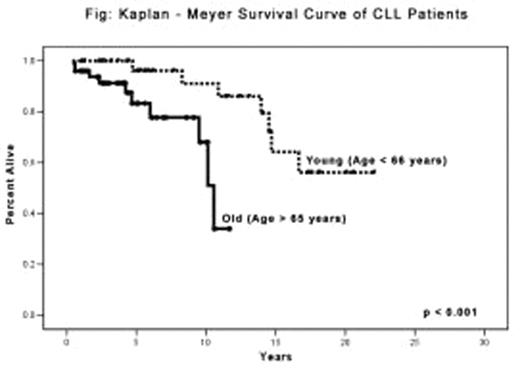Abstract
Background
Chronic lymphocytic leukemia (CLL), a chronic proliferative disorder of mature-looking B-lymphocytes, is the most common leukemia in the western world. CLL is a disease of elderly, with only 10–15% of patients affected at the age of less than 50 years. It is still controversial whether the clinical features and the impact on survival are different between younger and older patients, since the standard statistical methods produce contradicting results. In the present retrospective study of 87 CLL patients, we compared the data between patients above and below 65 years. The analysis of the impact of the disease on survival was carried out using a method described below.
Methods
Medical records and survival data were obtained from 87 patients with CLL treated in our Institute between 1983 and 2003. Statistical analysis of the clinical and laboratory parameters and survival data was performed using standard methods. The survival loss due to the disease as a percent of the expected survival of gender- and age-matched general population was determined, based on the survival analysis method developed and published recently [
Results
The mean age in the younger and older age groups was 56 and 74 years respectively. The male-to-female ratio was 2:1 in both age groups. The disease was found to be twice more common in patients from Ashkenazi compared with Sephardic descent. The younger group of patients had several features indicative of a more severe disease at presentation: advanced stage (Rai 2–4) – 46% vs. 16%, and diffuse involvement of bone marrow −60% vs. 18%. Younger patients were also more likely to require treatment (30% vs. 8% for fludarabine-containing regimens). Although according to the Kaplan-Meyer curve (see Fig.) a more favorable survival was shown for the younger group, the survival loss showed a reversed pattern. While the older patients lost 10% of the SPS, the survival loss in the younger patients was 44% (p=0.001).
Conclusions
CLL shows a strong male predominance and is more common in Ashkenazi than in Sephardic Jewish population in all ages.
CLL has a more unfavorable presentation and a more severe clinical course in the younger patients (age<66) than in the older age group (age>65).
The negative impact of the disease on the survival of CLL patients is higher in the younger patients, since their survival loss in comparison with the matched general population was 4.4 times higher, than that of the older patients. This mode of statistical evaluation confirms the impression that CLL is a more severe disease in younger patients.
Kaplan - Meyer Survival Curve of CLL Patients
Author notes
Corresponding author


